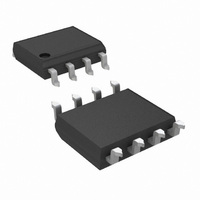LMV842QMA/NOPB National Semiconductor, LMV842QMA/NOPB Datasheet - Page 17

LMV842QMA/NOPB
Manufacturer Part Number
LMV842QMA/NOPB
Description
IC AMP R-R I/O LV LP DUAL 8SOIC
Manufacturer
National Semiconductor
Datasheet
1.LMV841MGNOPB.pdf
(22 pages)
Specifications of LMV842QMA/NOPB
Amplifier Type
General Purpose
Number Of Circuits
2
Output Type
Rail-to-Rail
Slew Rate
2.5 V/µs
Gain Bandwidth Product
4.5MHz
Current - Input Bias
0.3pA
Voltage - Input Offset
50µV
Current - Supply
1.03mA
Current - Output / Channel
37mA
Voltage - Supply, Single/dual (±)
2.7 V ~ 12 V, ±1.35 V ~ 6 V
Operating Temperature
-40°C ~ 125°C
Mounting Type
Surface Mount
Package / Case
8-SOIC (3.9mm Width)
Number Of Channels
2
Voltage Gain Db
133 dB
Common Mode Rejection Ratio (min)
81 dB
Input Offset Voltage
0.5 mV at 5 V
Operating Supply Voltage
3 V, 5 V, 9 V
Supply Current
3 mA at 5 V
Maximum Operating Temperature
+ 125 C
Minimum Operating Temperature
- 40 C
Lead Free Status / RoHS Status
Lead free / RoHS Compliant
-3db Bandwidth
-
Lead Free Status / Rohs Status
Details
Other names
LMV842QMA
Available stocks
Company
Part Number
Manufacturer
Quantity
Price
Part Number:
LMV842QMA/NOPB
Manufacturer:
NS/国半
Quantity:
20 000
Thermocouple Example
For this example suppose the range of interest is from 0°C to
500°C, and the resolution needed is 0.5°C. The power supply
for both the LMV841, LMV842, or LMV844 and the ADC is
3.3V.
The temperature range of 0°C to 500°C results in a voltage
range from 0mV to 20.6mV produced by the thermocouple.
This is shown in
To obtain the best accuracy the full ADC range of 0 to 3.3V is
used and the gain needed for this full range can be calculated
as follows:
A
V
= 3.3V / 0.0206V = 160.
FIGURE 8. K-Type Thermocouple Response
Figure
8.
FIGURE 9. Thermocouple Amplifier
20168370
17
If R
gain of 160. Since A
lows:
To get a resolution of 0.5°C a step smaller then the minimum
resolution is needed. This means that at least 1000 steps are
necessary (500°C/0.5°C). A 10-bit ADC would be sufficient
as this will give 1024 steps. A 10-bit ADC such as the two
channel 10-bit ADC102S021 would be a good choice.
Unwanted Thermocouple Effect
At the point where the thermocouple wires are connected to
the circuit, usually copper wires or traces, an unwanted ther-
mocouple effect will occur.
At this connection, this could be the connector on a PCB, the
thermocouple wiring forms a second thermocouple with the
connector. This second thermocouple disturbs the measure-
ments from the intended thermocouple.
Using an isothermal block as a reference will compensate for
this additional thermocouple effect . An isothermal block is a
good heat conductor. This means that the two thermocouple
connections both have the same temperature. The tempera-
ture of the isothermal block can be measured, and thereby
the temperature of the thermocouple connections. This is
usually called the cold junction reference temperature.
In the example, an LM35 is used to measure this temperature.
This semiconductor temperature sensor can accurately mea-
sure temperatures from −55°C to 150°C.
The ADC in this example also coverts the signal from the
LM35 to a digital signal. Now the microprocessor can com-
pensate the amplified thermocouple signal, for the unwanted
thermocouple effect.
R
G
F
is 2kΩ, then the value for R
= A
V
* R
G
= 160 x 2kΩ = 320kΩ
V
= R
F
/ R
G
, R
F
20168353
can be calculated with this
F
can be calculated as fol-
www.national.com











